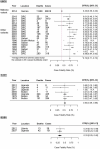Pathogenicity and Virulence of Ebolaviruses with Species- and Variant-specificity
- PMID: 33734027
- PMCID: PMC7993122
- DOI: 10.1080/21505594.2021.1898169
Pathogenicity and Virulence of Ebolaviruses with Species- and Variant-specificity
Abstract
Ebola virus (EBOV), belonging to the species Zaire ebolavirus in the genus Ebolavirus, causes a severe febrile illness in humans with case fatality rates (CFRs) up to 90%. While there have been six virus species classified, which each have a single type virus in the genus Ebolavirus, CFRs of ebolavirus infections vary among viruses belonging to each distinct species. In this review, we aim to define the ebolavirus species-specific virulence on the basis of currently available laboratory and experimental findings. In addition, this review will also cover the variant-specific virulence of EBOV by referring to the unique biological and pathogenic characteristics of EBOV variant Makona, a new EBOV variant isolated from the 2013-2016 EBOV disease outbreak in West Africa. A better definition of species-specific and variant-specific virulence of ebolaviruses will facilitate our comprehensive knowledge on genus Ebolavirus biology, leading to the development of therapeutics against well-focused pathogenic mechanisms of each Ebola disease.
Keywords: Bundibugyo virus; Ebola virus; Reston virus; Sudan virus; Taï Forest virus; case fatality rates; virulence.
Conflict of interest statement
No potential conflict of interest was reported by the authors.
Figures



References
-
- Centers for Disease Control . History of ebola virus disease. https://www.cdc.gov/vhf/ebola/history/chronology.html [accessed 15 October 2020].
Publication types
MeSH terms
Substances
Grants and funding
LinkOut - more resources
Full Text Sources
Other Literature Sources
Medical
